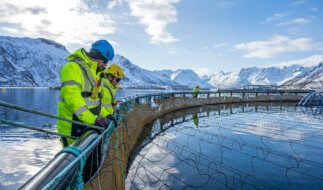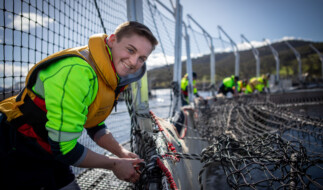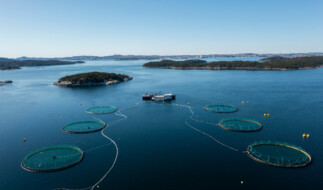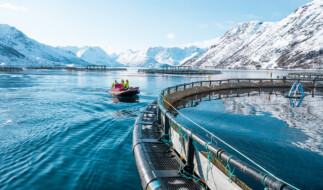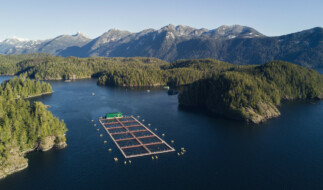Walking the Walk – What the GSI’s Vision for the Future of Aquaculture Means in Practice
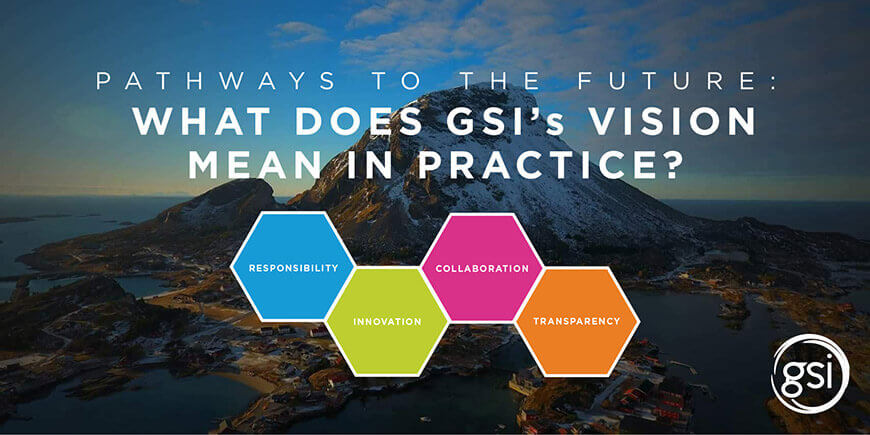
However, although it is easy to set an objective, it is not always so easy to achieve it. As we start a new year, we thought it was a good time to look at how we are incorporating these pathways – collaboration, responsibility, transparency and innovation – into our daily practices, and how we are using them as a framework to drive continuous improvements in our operations and to support us in making salmon aquaculture a sustainable practice for the future.
In this blog post, we look at each of the four pathways and see what they mean for our members.
Collaboration
Collaboration is one of the core principles of GSI membership. It is part of our philosophy that by working together, we can have a greater impact in improving the industry’s environmental performance than by working alone, and we can speed up the rate of improvements. We know that as an industry, we are not perfect and we face challenges, but by collaborating, we can bring together the shared expertise and experiences we have to problem-solve and identify ways to innovate and improve the salmon farming industry’s sustainability performance.
One area where we have found this collaborative approach to be most beneficial is within the GSI’s Biosecurity Taskforce. The Biosecurity Taskforce brings together fish health experts from each GSI member to create an open platform for discussing best practices related to disease management and fish welfare. Within this group, the members can share challenges and ask for advice, and review new developments to determine their usability for our salmon farms. Collaboration between competitors is not always a possibility, but in this situation, and to ensure the wider sustainability performance of the sector, we recognize that our vision can be achieved by working together and helping the whole sector move forward.
“Being a member of the GSI Biosecurity Taskforce offers me a unique position – I can now connect with a group of experts from all over the world. If I have a situation or a challenge that is new to me and I am not sure of the best approach to take, I can raise it within the group to see if they have the knowledge of what to do. It not only helps me determine the best management strategy, but it can also save me a lot of time and resources in figuring it out.”
“One example of this is when Chile was hit by harmful algal blooms in 2016, which had a disastrous impact on our farms and the health of our fish, and we were not familiar with the best methods to prevent this. Through the GSI, we have been able to hear from other regions who have had the same challenge and learn from their experiences on the best approaches. We now have much more information, and are able to see what techniques might work best here in Chile. Without the GSI, it would have been very difficult for us to have this exchange.”Alejandro Heisinger, Fish Health Manager at Multiexport Foods, and GSI Biosecurity Taskforce member
Transparency
From the very outset of establishing the GSI, we understood the power of transparency as a means of building trust and demonstrating progress – not only to our stakeholders, but also between each other. For us, progress towards a sustainable future for aquaculture will only be possible if we act transparently – and engage our stakeholders in our journey of continuous progress. One of the key commitments of being a GSI member is sharing key sustainability data via our annual GSI Sustainability Report, and now with 5 years of data it is a prime example of how being transparent is a crucial ingredient in benchmarking progress.
“The GSI's commitment to transparency is evidence that it is committed to building a sustainable future. With 5 years of environmental data, it is promising to see positive trends emerging. We look forward to the industry continuing to move forward as well as increasing ASC certification to 100%.”Aaron McNevin, Global Aquaculture Lead, World Wildlife Fund (WWF)
There remain areas in our performance where we acknowledge there is still need for development, but having the data on our actual performance in the public domain means we can be judged on our true performance and dispel any myths or misconceptions. It also means we can more easily measure and demonstrate our progress – enabling us, and our stakeholders, to be confident in our progress.
We have also learnt that being transparent facilitates productive conversations with our stakeholders and neighbors – meaning we can develop stronger and more meaningful relationships and work together on shaping the future of the farmed salmon industry. You can read more on why transparency is so important for us at the Global Salmon Initiative in this blog post here.
Responsibility
In our increasingly environmentally conscious world, we understand more fully how our collective and individual actions affect the planet. In order to ensure a sustainable future for the farm-raised salmon sector, and aquaculture more generally, it is all of our responsibility to respect and protect the planet, its resources, and those who share it with us. This is why we have chosen responsibility as one of our Pathways to the Future.
It is not always easy to know exactly what constitutes being responsible, so to help guide us, GSI members decided to use the Aquaculture Stewardship Council (ASC Certification) as our reference point for responsible farming. The ASC outlines three elements for responsible aquaculture:
- Being respectful of the environments we operate in
- Ensuring healthy fish
- Positively contributing to local communities
The ASC Salmon Standard has 156 individual data points that are used to measure our salmon farming operations, and we are proud to say that we now have 50% of our GSI member production ASC-certified and we continue on the path to achieving 100%.
You can learn more about ASC Certification in this video:
“Five years ago there were no ASC-certified salmon farms, and committing to reaching 100% ASC certification was ambitious and difficult. There were so many metrics to achieve, and a lot of changes to implement to achieve the high standards they require, but we knew it was necessary to ensure we were performing to the highest levels of responsible production.”
“As salmon farmers we get to work in the most beautiful environments – surrounded by expansive oceans and mountains – and it is our priority not only to raise the healthiest fish, but also to keep the ocean healthy. By ensuring the sustainable future of our environments, we can support a sustainable future for the industry.”Alfredo Tello Gildemeister, Technical Manager at Camanchaca
Innovation
We could not think about the future of aquaculture, or the future of food more generally, without including innovation. Innovation will be what allows us to keep improving, and most importantly allow us to meet the growing demand for protein and seafood while using fewer resources with minimal environmental impact. Innovation will also support us in addressing new challenges as they arise and continue to improve our operations so they are more effective and more efficient.
Salmon farming is one of the most technically advanced forms of aquaculture; from the way our pens are designed to how we feed the fish, the industry is continually investing in research and development to identify new and improved ways of farming salmon. You can read more about some of these developments in our feature on the top five innovations in salmon farming here.
“One of the biggest innovations to have taken place in salmon farming in the past decade is the significant reduction in the use of wild fish as part of the farmed fish’s diet. Through innovation and improvements in feeding techniques, we have not only been able to reduce the amount of marine resources needed, but also been able to identify new novel resources to replace the marine oils we required before. This has meant that in the 40 years that the salmon farming industry has been operating, we have been able to reduce our marine dependency from almost 80% to approximately 25%.”Tor Eirik Homme, Director Feed and Nutrition at Grieg Seafood ASA
Making our Vision a Reality
As salmon farmers, we know there are things that we cannot control, but what we can control is ensuring we make the most of the resources and expertise we have. This approach will best prepare us for the long term and set ourselves up to have the greatest chance of creating a future industry that is not only environmentally sustainable, but also socially and economically sustainable. Our Pathways framework is a guide for our activities and ensures we continue to head in the right direction. By keeping these four principles – collaboration, transparency, responsibility and innovation – at the core of our operations, we hope to position ourselves in the best way to support significant sustainable growth for the long-term success of the aquaculture industry.
